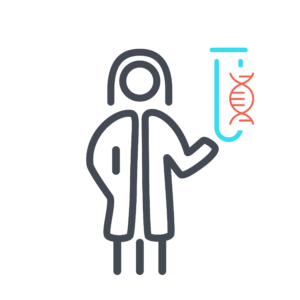DNMT3A-Related Syndrome

Table of contents
- What is DNMT3A-related syndrome?
- Key Role
- Symptoms
- What causes DNMT3A-related syndrome?
- Why does my child have a change in the DNMT3A gene?
- What are the chances that other family members of future children will have DNMT3A-related syndrome?
- How many people have DNMT3A-related syndrome?
- Do people who have DNMT3A-related syndrome look different?
- Behavior and development concerns linked to DNMT3A-related syndrome
- Where can I find support and resources?
- Sources and References
What is DNMT3A-related syndrome?
DNMT3A-related syndrome happens when there are changes in the DNMT3A gene. These changes can keep the gene from working as it should.
Genetic variants in DNMT3A can cause Tatton-Brown-Rahman syndrome or Heyn-Sproul-Jackson syndrome. The type of genetic condition a person has depends on the location of the genetic variant within the gene.

Key Role
The DNMT3A gene plays an important role in controlling other genes, inactivating DNA, and inactivating the X chromosome.
Symptoms
People with Tatton-Brown-Rahman syndrome may have:
- Intellectual disability
- Seizures
- Brain changes seen on magnetic resonance imaging (MRI)
- Low muscle tone
- Some increased risk for blood cancers
- Larger than average head size, also called macrocephaly
- Taller than average
- Obesity
People with Heyn-Sproul-Jackson syndrome may have:
- Global developmental delay
- Intellectual disability
- Speech issues
- Smaller than average head size, also called microcephaly
- Short height and low weight
What causes DNMT3A-related syndrome?
DNMT3A-related syndrome is a genetic condition, which means that it is caused by variants in genes. Our genes contain the instructions, or code, that tell our cells how to grow, develop, and work. Every child gets two copies of the DNMT3A gene: one copy from their mother’s egg, and one copy from their father’s sperm. In most cases, parents pass on exact copies of the gene to their child. But the process of creating the egg or sperm is not perfect. A change in the genetic code can lead to physical issues, developmental issues, or both.
Sometimes a spontaneous variant happens in the sperm, egg or after fertilization. When a brand new genetic variant happens in the genetic code is called a ‘de novo’ genetic variant. The child is usually the first in the family to have the genetic variant.
De novo variants can take place in any gene. We all have some de novo variants, most of which don’t affect our health. But because DNMT3A plays a key role in development, de novo variants in this gene can have a meaningful effect.
Research shows that DNMT3A-related syndrome is often the result of a de novo variant in DNMT3A. Many parents who have had their genes tested do not have the DNMT3A genetic variant found in their child who has the syndrome. In some cases, DNMT3A-related syndrome happens because the genetic variant was passed down from a parent.
Autosomal dominant conditions
DNMT3A-related syndrome is an autosomal dominant genetic condition. This means that when a person has the one damaging variant in DNMT3A they will likely have symptoms of DNMT3A-related syndrome. For someone with an autosomal dominant genetic syndrome, every time they have a child there is a 50 percent chance they pass on the same genetic variant and a 50 percent chance they do not pass on the same genetic variant.
Autosomal Dominant Genetic Syndrome
Why does my child have a change in the DNMT3A gene?
No parent causes their child’s DNMT3A-related syndrome. We know this because no parent has any control over the gene changes that they do or do not pass on to their children. Please keep in mind that nothing a parent does before or during the pregnancy causes this to happen. The gene change takes place on its own and cannot be foreseen or stopped.
What are the chances that other family members of future children will have DNMT3A-related syndrome?
Each family is different. A geneticist or genetic counselor can give you advice on the chance that this will happen again in your family.
The risk of having another child who has DNMT3A-related syndrome depends on the genes of both biological parents.
- If neither biological parent has the same genetic variant found in their child, the chance of having another child who has the syndrome is on average 1 percent. This 1 percent chance is higher than the chance of the general population. The increase in risk is due to the very unlikely chance that more of the mother’s egg cells or the father’s sperm cells carry the same genetic variant.
- If one biological parent has the same genetic variant found in their child, the chance of having another child who has the syndrome is 50 percent.
For a symptom-free brother or sister of someone who has DNMT3A-related syndrome, the sibling’s risk of having a child who has DNMT3A-related syndrome depends on the sibling’s genes and their parents’ genes.
- If neither parent has the same genetic variant causing DNMT3A-related syndrome, the symptom-free sibling has a nearly 0 percent chance of having a child who would inherit DNMT3A-related syndrome.
- If one biological parent has the same genetic variant causing DNMT3A-related syndrome, the symptom-free sibling has a 50 percent chance of also having the same genetic variant. If the symptom-free sibling has the same genetic variant, their chance of having a child who has the genetic variant is 50 percent.
For a person who has DNMT3A-related syndrome, the risk of having a child who has the syndrome is about 50 percent.

How many people have DNMT3A-related syndrome?
As of 2024, at least 115 people with genetic variants in DNMT3A have been described in medical research.

Do people who have DNMT3A-related syndrome look different?
People with Tatton-Brown-Rahman syndrome may have:
- Tall height
- Larger than average head
- Hypermobile joints
- Sideways curve of the spine, also called scoliosis
People with Heyn-Sproul-Jackson syndrome may have:
- Short height
- Low weight
- Smaller than average head
- Thinning hair

Scientists and doctors have only just begun to study DNMT3A-related syndrome. At this point, there are no medicines designed to treat the syndrome. A genetic diagnosis can help people decide on the best way to track the condition and manage therapies. Doctors can refer people to specialists for:
- Physical exams and brain studies
- Genetics consults
- Development and behavior studies
- Other issues, as needed
A developmental pediatrician, neurologist, or psychologist can follow progress over time and can help:
- Suggest the right therapies. This can include physical, occupational, speech, or behavioral therapy.
- Guide individualized education plans (IEPs).
Specialists advise that therapies for DNMT3A-related syndrome should begin as early as possible, ideally before a child begins school.
If seizures happen, consult a neurologist. There are many types of seizures, and not all types are easy to spot. To learn more, you can refer to resources such as the Epilepsy Foundation’s website: epilepsy.com/learn/types-seizures.

This section includes a summary of information from major published articles. It highlights how many people have different symptoms. To learn more about the articles, see the Sources and References section of this guide.
Behavior and development concerns linked to DNMT3A-related syndrome
Loss of function genetic variants in DNMT3A, such as a gene deletion, frameshift, or nonsense genetic variant, result in Tatton-Brown-Rahman syndrome.
Gain of function genetic variants in DNMT3A that are located in a particular region of the gene result in Heyn-Sproul-Jackson syndrome. People described in the medical research had missense variants at amino acids 302, 306, 330, and 333.
Tatton-Brown-Rahman syndrome
Learning
All people with Tatton-Brown-Rahman syndrome had developmental delay or intellectual disability.
- 114 out of 114 people had developmental delay or intellectual disability (100 percent)
The severity of intellectual disability (ID) varied among people:
- 27 out of 97 people had mild ID (28 percent)
- 56 out of 97 people had moderate ID (58 percent)
- 14 out of 97 people had severe ID (14 percent)

Behavior
Many people with Tatton-Brown-Rahman syndrome had behavioral issues, most commonly autism. Other behavioral issues included anxiety, aggression, psychotic disorders, bipolar disorder, or obsessive behaviors.
- 15 out of 24 people had behavioral issues (63 percent)
- 15 out of 42 people had features of autism (36 percent)
Brain
Some people with Tatton-Brown-Rahman syndrome had seizures, a larger than average head size at birth (macrocephaly), and lower than average muscle tone (hypotonia). People had brain changes seen on magnetic resonance imaging (MRI), most often thin or dysplastic corpus callosum or non-specific findings.
- 22 out of 79 people had seizures (28 percent)
- 60 out of 112 people had macrocephaly (54 percent)
- 56 out of 114 people had hypotonia (49 percent)
- 13 out of 18 people had brain changes seen on MRI (72 percent)

Growth
Most people with Tatton-Brown-Rahman syndrome had overgrowth and were overweight. Some people had a sideways curve of the spine (scoliosis) or a forward rounding of the upper back (kyphosis).
- 54 out of 74 people had overgrowth (73 percent)
- 48 out of 73 people were overweight (66 percent)
Tumors
Research studies have suggested that there might be an increased risk of blood cancer in people with Tatton-Brown-Rahman syndrome.
Other features
People with Tatton-Brown-Rahman syndrome had heart findings, including an enlargement of part of the heart (aortic root dilation), stretched out valve in the heart (mitral valve prolapse), enlarged chambers of the heart (dilated cardiomyopathy), or dysregulated heart beats.
Heyn-Sproul-Jackson syndrome
Learning
All people with Heyn-Sproul-Jackson syndrome had developmental delay or intellectual disability.
- 4 out of 4 people had developmental delay or intellectual disability (100 percent)
Brain
People with Heyn-Sproul-Jackson syndrome had a smaller than average head size at birth (microcephaly), but no brain changes were seen on magnetic resonance imaging (MRI).
- 4 out of 4 people had microcephaly (100 percent)
Growth
People with Heyn-Sproul-Jackson syndrome were shorter than average and had lower than average weight.

Where can I find support and resources?
Simons Searchlight
Simons Searchlight is an online international research program, building an ever growing natural history database, biorepository, and resource network of over 175 rare genetic neurodevelopmental disorders. By joining their community and sharing your experiences, you contribute to a growing database used by scientists worldwide to advance the understanding of your genetic condition. Through online surveys and optional blood sample collection, they gather valuable information to improve lives and drive scientific progress. Families like yours are the key to making meaningful progress. To register for Simons Searchlight, go to the Simons Searchlight website at www.simonssearchlight.org and click “Join Us.”
- Learn more about Simons Searchlight: www.simonssearchlight.org/frequently-asked-questions
- Simons Searchlight webpage with more information on DNMT3A: www.simonssearchlight.org/research/what-we-study/dnmt3a
- Simons Searchlight Facebook group: https://www.facebook.com/groups/dnmt3a

Sources and References
The content in this guide comes from published studies about DNMT3A-related syndrome.
- Kim, G. H., Kim, J., Lee, J., & Jang, D. H. (2023). A novel pathogenic variant of DNMT3A associated with craniosynostosis: A case report of Heyn-Sproul-Jackson syndrome. Frontiers in Pediatrics, 11, 1165638. https://pmc.ncbi.nlm.nih.gov/articles/PMC10248406/
- Ostrowski, P. J., & Tatton-Brown, K. Tatton-Brown-Rahman syndrome. 2022 Jun 30. In: Adam MP, Feldman J, Mirzaa GM, et al., editors. GeneReviews® [Internet]. Seattle (WA): University of Washington, Seattle; 1993-2024. Available from: https://www.ncbi.nlm.nih.gov/sites/books/NBK581652/
- Thomas, H., Alix, T., Renard, É., Renaud, M., Wourms, J., Zuily, S., Leheup, B., Geneviève, D., Dreumont, N., … & Bonnet, C. (2024). Expanding the genetic and clinical spectrum of Tatton-Brown-Rahman syndrome in a series of 24 Fench patients. Journal of Medical Genetics, 61(9), 878-885. https://pubmed.ncbi.nlm.nih.gov/38937076/
